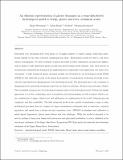Files in this item
An efficient representation of glacier dynamics in a semi-distributed hydrological model to bridge glacier and river catchment scales
Item metadata
| dc.contributor.author | Wortmann, Michel | |
| dc.contributor.author | Bolch, Tobias | |
| dc.contributor.author | Buda, Su | |
| dc.contributor.author | Krysanova, Valentina | |
| dc.date.accessioned | 2020-03-18T00:33:14Z | |
| dc.date.available | 2020-03-18T00:33:14Z | |
| dc.date.issued | 2019-06 | |
| dc.identifier | 258172729 | |
| dc.identifier | 461eb5b3-d359-40d5-85a6-da2c8591ce47 | |
| dc.identifier | 85063458489 | |
| dc.identifier | 000474327800011 | |
| dc.identifier.citation | Wortmann , M , Bolch , T , Buda , S & Krysanova , V 2019 , ' An efficient representation of glacier dynamics in a semi-distributed hydrological model to bridge glacier and river catchment scales ' , Journal of Hydrology , vol. 573 , pp. 136-152 . https://doi.org/10.1016/j.jhydrol.2019.03.006 | en |
| dc.identifier.issn | 0022-1694 | |
| dc.identifier.other | ORCID: /0000-0002-8201-5059/work/55643855 | |
| dc.identifier.uri | https://hdl.handle.net/10023/19669 | |
| dc.description | This study was conducted within the project SuMaRiO (Sustainable Management of River Oases along the Tarim River; http://www.sumario.de/), funded by the German Federal Ministry of Education and Re- search (BMBF grants 01LL0918J and 01LL0918B). T. Bolch acknowledges funding by Deutsche Forschungs- gemeinschaft (DFG, Code BO3199/2-1). The authors gratefully acknowledge the European Regional Devel- opment Fund (ERDF), the German Federal Ministry of Education and Research and the Land Brandenburg for supporting this project by providing resources on the high performance computer system at the Potsdam Institute for Climate Impact Research. | en |
| dc.description.abstract | Glacierised river catchments have been shown to be highly sensitive to climate change, while large populations depend on the water resources originating from them. Hydrological models are used to aid water resource management, yet their treatment of glacier processes is either rudimentary in large-scale applications or linked to fully distributed glacier models that prevent larger model domains. Also, data scarcity in mountainous catchments has hampered the implementation of physically based approaches over entire river catchments. A fully integrated glacier dynamics module was developed for the hydrological model SWIM (SWIM-G) that takes full account of the spatial heterogeneity of mountainous catchments but keeps in line with the semi-distributed disaggregation of the hydrological model. The glacierised part of the catchment is disaggregated into glaciological response units that are based on subbasin, elevation zone and aspect classes. They seamlessly integrate into the hydrological response units of the hydrological model. Robust and simple approaches to ice ow, avalanching, snow accumulation and metamorphism as well as glacier ablation under consideration of aspect, debris cover and sublimation are implemented in the model, balancing process complexity and data availability. The fully integrated model is also capable of simulating a range of other hydrological processes that are common for larger mountainous catchments such as reservoirs, irrigation agriculture and runoff from a diverse soil and vegetation cover. SWIM-G is initialised and calibrated to initial glacier hypsometry, glacier mass balance and river discharge. While the model is intended to be used in medium to large river basins with data-scarce and glacierised headwaters, it is here validated in the data-scarce catchment of the Upper Aksu River, Kyrgyzstan/NW China and in the relatively data-abundant catchment of the Upper Rhone River, Switzerland. | |
| dc.format.extent | 2982658 | |
| dc.language.iso | eng | |
| dc.relation.ispartof | Journal of Hydrology | en |
| dc.subject | Glaciohydrological model | en |
| dc.subject | SWIM | en |
| dc.subject | Aksu basin | en |
| dc.subject | Rhone basin | en |
| dc.subject | Glacier mass balance modelling | en |
| dc.subject | GE Environmental Sciences | en |
| dc.subject | 3rd-DAS | en |
| dc.subject | SDG 13 - Climate Action | en |
| dc.subject.lcc | GE | en |
| dc.title | An efficient representation of glacier dynamics in a semi-distributed hydrological model to bridge glacier and river catchment scales | en |
| dc.type | Journal article | en |
| dc.contributor.institution | University of St Andrews. Bell-Edwards Geographic Data Institute | en |
| dc.contributor.institution | University of St Andrews. School of Geography & Sustainable Development | en |
| dc.identifier.doi | 10.1016/j.jhydrol.2019.03.006 | |
| dc.description.status | Peer reviewed | en |
| dc.date.embargoedUntil | 2020-03-18 |
This item appears in the following Collection(s)
Items in the St Andrews Research Repository are protected by copyright, with all rights reserved, unless otherwise indicated.

